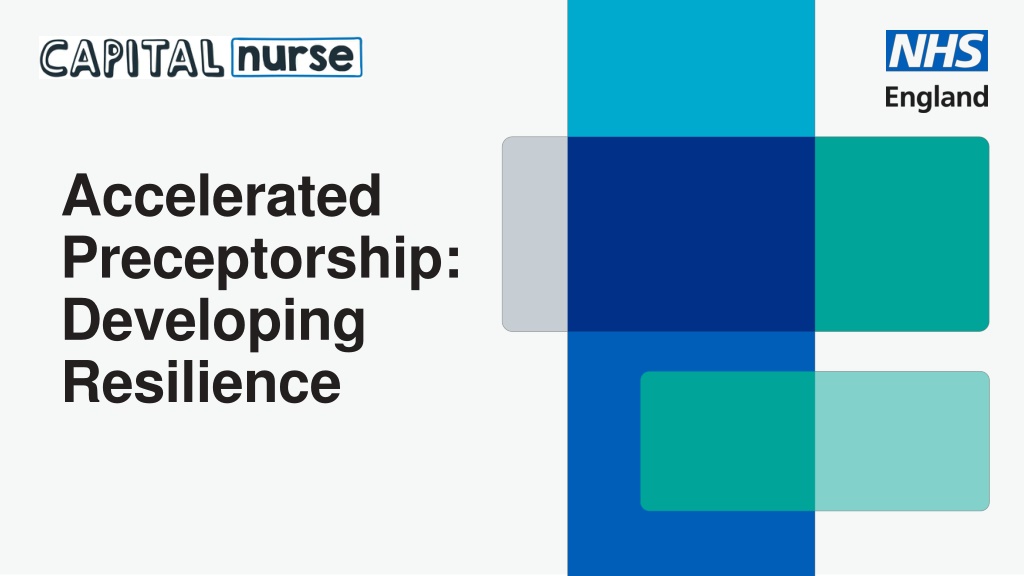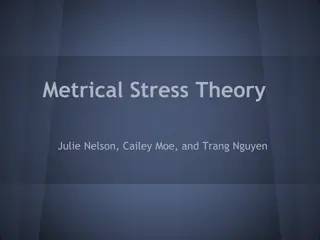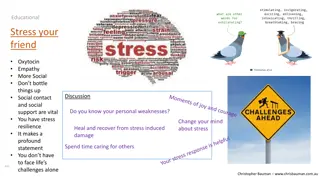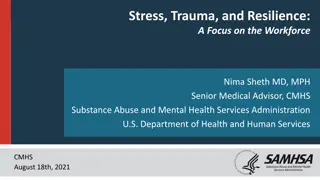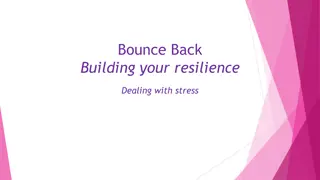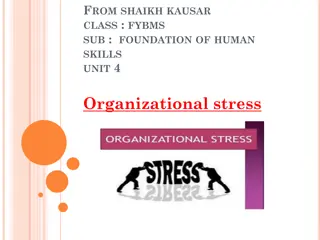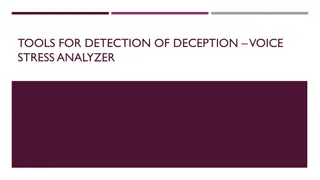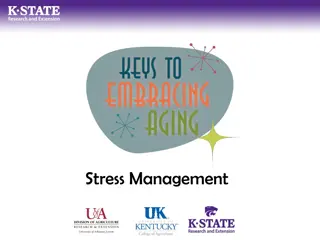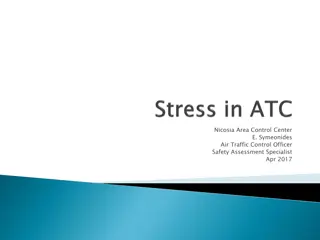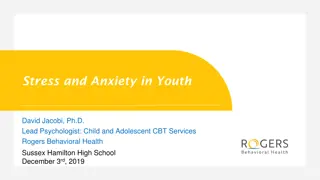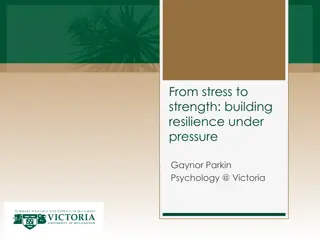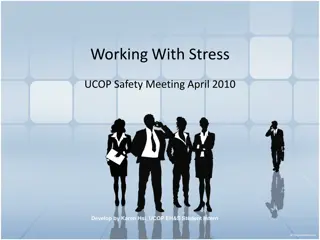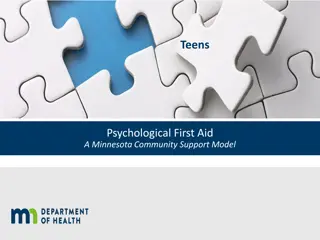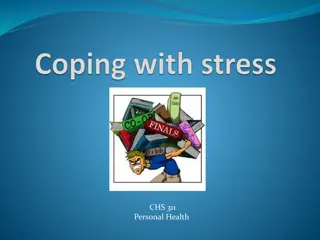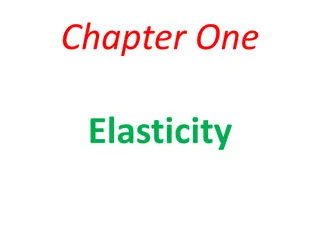Understanding Stress and Building Resilience in the Workplace
Explore the impact of stress on staff, identify sources and symptoms of stress, and learn strategies for developing resilience. Understand the importance of managing stress factors, recognizing triggers, and enhancing personal well-being to foster a resilient work environment. Discover ways to combat demotivation, improve efficiency, and enhance team synergy through stress management techniques.
Download Presentation

Please find below an Image/Link to download the presentation.
The content on the website is provided AS IS for your information and personal use only. It may not be sold, licensed, or shared on other websites without obtaining consent from the author. Download presentation by click this link. If you encounter any issues during the download, it is possible that the publisher has removed the file from their server.
E N D
Presentation Transcript
Accelerated Preceptorship: Developing Resilience
Objectives By the end of the session, you will: be aware of stress factors, symptoms and impact understand what resilience means understand the 7 Cs of resilience and how to apply to yourself be able to identify ways of developing resilience be aware of different sources of support. 2
What is stress? The adverse reaction people have to excessive pressures or other types of demand placed on them . Health and Safety Executive 3
Impact on staff Stress causes demotivation and disengagement Tasks are not done to the same quality or to deadline Knock-on effect on colleagues causing frustration and poor team synergy, increased workload and associated pressure Reduced efficiency and performance Staff lacking skills and competency Poor level of service for customers 4
Reflection What causes you stress? Can you identify certain triggers? How do you feel when you are stressed? 5
Sources of stress Stress is different for everyone, and the sources are therefore different. However, they can be identified into three main categories: Personal Financial problems Personal problems Pace of life Commitments Social environment Poor physical health Poor mental health Role Too much to do Not enough to do Role confusion Working relationships Lack of feedback Uncertainty / change Organisational culture Bullying / Harassment Organisational Working patterns Nature of work Working environment Management style Organisational culture Poor team working Change and restructure Level of management control 6
Symptoms of stress Physical Mental Emotional Behavioural Headaches Panic attacks Frequent illness Nausea Weight loss / gain Poor sleeping habits Indecisiveness Forgetfulness Making mistakes Poor concentration Worrying over trivial matters Loss of perspective Irritability Loss of confidence General depression Crying Fear and anxiety Taking offence Lack of sociability Restlessness Unable to focus Poor time management Withdrawal 7
Stress curve HIGH Motivated, energetic enthusiastic Peak performance Performance Motivation kicking in, less tired Getting there Anxious, stressed, tired, distracted Caution Lethargy, tiredness, demotivation, lack of enthusiasm - Rust-out Exhaustion, anxiety, stress, panic, overloaded anger - Burnt out LOW HIGH Level of stress 8
Reflection What does resilience mean to you in your role and workplace? Who can you think of who illustrates resilience and demonstrates it in their life? How resilient do you think you are? 9
What is resilience? A dictionary definition: the ability to be happy, successful, etc. again after something difficult or bad has happened: - trauma researchers emphasize the resilience of the human psyche the ability of a substance to return to its usual shape after being bent, stretched, or pressed: - the plant fibre has incredible strength and resilience. 10
Definitions of resilience Werner (1995) defines resilience in relation to three central usages: good developmental outcomes despite high-risk status sustained competence under stress recovery from trauma. Luthar (2006) defines resilience as positive adaptation despite adversity. For him, it is built up of two things which, when measured, offer an indication of resilience: significant adversity positive adaptation. 11
7Cs of resilience Dr. Ginsburg is a paediatrician specialising in Adolescent Medicine at the Children's Hospital of Philadelphia. He defines 7 elements that make up resilience. He believes that these are integral and inter-related to being resilient: competence confidence connection character contribution coping control. 12
Competence Competence is the ability to handle difficult and stressful situations effectively. You may have to face challenges and deal with a range of stressful situations, but as you experience more and more of these, your competence grows. Tip: When in a difficult situation and doubting your competence, consider previous similar situations. Think about how you coped previously and use that to increase self-belief that you can handle your current challenge. 13
Confidence Confidence is your belief in yourselves and your own ability. It is knowing yourself, your competences, your values, your beliefs and your qualities. Self-confidence is essential to help you grow and develop. A sense of confidence helps you to cope in stressful situations and to maintain a health emotional and physical wellbeing. Tip: When you re feeling overwhelmed, stressed or lacking confidence, remind yourself of who you are as an individual, your values and beliefs. Identify areas of strength and focus on these. 14
Reflection How confident do you feel in your current role / workplace? Now think about times / situations when you have felt very confident and think about how you can use this to boost your confidence. 15
Connection In stressful situations, we often feel isolated and alone and our natural response to stress can be to withdraw from others. Sharing problems, concerns and worries with others (colleagues, friends, family) can help to establish a sense of connection and feeling of normality. Human touch also validates us as individuals and boosts our self-esteem. Tip: When you re feeling very stressed or face a challenging situation, instead of withdrawing, surround yourself with other people, find someone to talk to and share your concerns. 16
Reflection How well connected do you feel to others? - In the workplace - Family - Friends and colleagues Do you find this changes when you re in difficult situations? Have you got someone you can offload to when things are stressful and challenging? 17
Character There are links between strong character and high resilience. These character traits include having a positive attitude, looking on the bright side, focusing on goals and having a clear purpose. These traits help to develop emotional stability. Tip: In stressful situations, focus on the positive traits of your character to help you draw inner strength and develop resilience in difficult situations. 18
Contribution Our contribution to the world reminds us of who we are and our place in the lives of others. Making a difference to someone helps us to feel good and can boost our self- esteem. Contribution to teams, patients and families can build connection with others and develop our self-confidence. Tip: When you re feeling stressed or challenged, remind yourself of what you contribute to others and the difference it makes to them. 19
Reflection Make a point of giving positive feedback to three other people over the next couple of days. Consider their reaction how does this make you feel? 20
Coping Our coping skills are essential in developing our resilience. However, we are all individuals and find different way of coping with different situations. Strategies may include meditation, exercise, fresh air, talking to others, listening to relaxing music. Tip: Identify your coping strategies and use these in difficult situations to help developing your resilience. 21
Reflection What coping strategies are you aware of? Which ones are most appropriate for you? 22
Control Rotter s (1966) Locus of Control theory suggests that the level of control we have over a situations influences our resilience. Those with a strong internal locus of control have an increased ability to interpret and manage difficult situations. This in turn increases their confidence and resilience in challenging circumstances. Tip: Remind yourself of your ability and confidence in difficult situations to help you manage a challenge more effectively. 23
Reflection Take a recent situation which you found challenging, where you faced adversity or difficulty. Apply each of the 7Cs to your response to see how resilient you were able to be. Then, consider the questions on the next slide. 24
How resilient was / am I? Did you feel fully competent and able to deal with the situation at hand? How much trust and faith did you have in your own / others abilities to deal with the situation? How far did you connect to others during / after the situation? Do you feel that you are strong enough to handle the situation? Did you contribute to help resolve the situation? Are you able to cope, emotionally and physically, with the fallout of the situation? How in control of the situation did you feel? 25
When we learn how to become resilient, we learn how to embrace the beautifully broad spectrum of the human experience. Jaeda Dewalt 26
Barriers to resilience An imbalance between work and personal life Overexposure to stressful events Insufficient time and space to process negative feelings Humiliating experiences Social isolation Feeling stressed and burnt out 27
Reflection On a scale of one to ten, rate how far you feel that the five barriers to resilience affect you. - 1 = not at all -10 = completely How can you overcome these barriers? 28
Building resilience skills How aware are you of your body, thoughts feelings and emotions? Do you understand your triggers of stress, how these will impact and how to manage? Being Where is your attention focussed? Being more in the present helps you be more engaged in the current situation rather than worrying about future or past Focus What is your physical health and wellbeing like? Do you exercise to help release physical stress? Physical How would you rate your mental and emotional wellbeing? Are there areas you can improve? Are there activities that may help you? Mental How is your general attitude to work and life do you feel more positive or negative? Positivity 29
Being: self-awareness Self-awareness is awareness of your body: its feelings, desires, urges, and needs. It is also awareness of your thoughts, thinking patterns, and emotions. It is also understanding of the mind-body relationship and how each of these connect and respond to each other. Self-awareness is the first step towards having choice and control. If your body / thoughts are operating out of your awareness, they control you. It s only by opening up awareness towards them that you can start to control them and choose to pause, consider, decide, and then act. Self-awareness is the foundation of all other resilience skills. 30
Quick check-in Being: how self aware are you? Focus: where is your primary focus: past / present / future? Physical release: how would you rate your physical wellbeing? Mental release: how would you rate your mental wellbeing? Maintaining positivity: how optimistic do you feel about your life and current situation? 31
Starter steps to resilience Can you come up with some easy ways to try and become more resilient? Focus on things that you can weave into your everyday life (for example, smiling more, practising mindfulness each morning / evening, keeping a gratitude journal ). 32
10 starter steps to resilience 1. Keep a gratitude journal 2. Plan enjoyable things to look forward to 3. Spend time with family and friends 4. Meditation / breathing exercises 5. Mindfulness 6. Find a purpose and commit to it on a daily basis 7. Smile more 8. Yoga / gentle stretching and exercise 9. Take a walk 10. Focus on the positive 33
Resilience at work 1. Share difficulties / ambiguities with colleagues and other staff members 2. Practice mindfulness whilst carrying out your work 3. Focus on the task at hand, rather than the future or the what if of the unknown 4. Prioritise and plan out your tasks to reduce feeling overwhelmed 5. Take every opportunity you can to learn more and commit to learning 34
Wellbeing strategies There is a number of different strategies to help you improve your mental and emotional well-being. Not every technique works for every individual it is about finding which works best for you. The next few slides provide some different ideas for you and further resources are available on the CapitalNurse website under compassionate education . 35
Sources of support Asking for help when you need it is a sign of strength and should be your first action when feeling overwhelmed. There are various sources of support available: your preceptor your manager colleagues Professional Nurse Advocate (PNA). 36
Professional Nurse Advocate The role of the PNA is to provide restorative supervision to nursing and midwifery support. Every organisation offers access to the PNA programme. Each PNA is specially trained to provide restorative supervision. Restorative supervision is particularly effective in reducing burnout and stress by providing an opportunity for discussion and reflective learning following an incident or in challenging situations. The PNA will help an individual to gain perspective and take control in difficult times. 37
Next steps Pair up with a buddy . Pick two actions (each) to carry out over the following week, to help build your resilience. Set a time, roughly one week in advance, to meet up again Check in with your buddy to see how far each of you have managed to try your resilience building activities into your week 38
FOFBOC Feet on Floor, Body On Chair Developed as a mindfulness technique, this 3-minute method takes you from 'fight or flight' to 'rest and digest' which can help after a difficult intervention: Sit on a chair with feet resting on the floor Feel your body on the chair Now feel your feet on the floor Think about your legs and how they feel moving onto lower body Focus on your belly, then your breathing Sit and relax for just a couple of minutes tuned into an awareness of your body 39
Body awareness A technique to help you focus on yourself in the present. You can do this sitting or standing. Focus on how your body feels from head to toe, noticing each part in turn: Can you feel your hair around your face, forehead, or shoulders? Glasses on your ears or your nose? Any earrings in your ears or necklace around your neck? The weight of your shirt on your shoulders? What position are your arms in? Do they feel relaxed or tense? Can you feel your heartbeat? Is it rapid or steady? Does your stomach feel full, or are you hungry? Are your legs crossed, or are your feet resting on the floor? Is your back straight? Curl your fingers and wiggle your toes. Are you barefoot or in shoes? Are your feet warm or cold? How does the floor feel against your feet? 40
5-4-3-2-1 A ground technique to help refocus Use your senses and see what you can sense in the world around you. Work backwards from 5 to notice: 5 things you can see 4 things you can feel 3 things you can hear 2 things you can smell 1 thing you can taste. 41
Category thinking Refocus activity This simple activity helps distract your mind whilst focusing on something meaningless. It helps to refocus your energy. Take a category for example: musical instruments, or ice cream flavours. Give yourself a minute or two to list as many things from that category as possible. 42
I remember, I remember I remember, I remember, The house where I was born, The little window where the sun Came peeping in at morn Choose a happy memory. Then close your eyes and think about: what are you doing? where are you? who s with you? what can you feel? 43
3-4-5 Breathing This simple breathing techniques helped you to reduce the activation of your stress state and encourage your body to move into a 'thrive' state. Find a quiet place, you may want to close your eyes: breathe in for three seconds hold your breath for four seconds breathe out for five seconds repeat for a few minutes. 44
Box Breathing Another breathing technique which will help to diffuse stress and refocus attention. Breathe in counting to four slowly. Feel the air enter your lungs. Hold your breath for four seconds. Try to avoid inhaling or exhaling for four seconds. Slowly exhale through your mouth for four seconds. Repeat steps above until you feel re-centered. 45
These are a few of my favourite things! Create a list of three things you love these could be people, places, objects, foods, animals Visualise each of them, one at a time: what does it look like? sound like? feel like? taste like? smell like? what does it remind you of? are there any associated memories? 46
References https://dictionary.cambridge.org/dictionary/english/resilience - accessed 4/8/2023 https://cbtprofessionals.com.au/the-7-cs-of-resilience/ - accessed 10/8/2023 Rutter Rutter M. Resilience concepts and findings: Implications for family therapy. Journal of Family Therapy. 1999;21:119 144. Luthar - Luthar SS. Resilience in development: A synthesis of research across five decades. In: Cicchetti D, Cohen DJ, editors. Developmental Psychopathology: Risk, Disorder, and Adaptation. New York: Wiley; 2006. pp. 740 795. Werner - Werner E. Resilience in development. Current Directions in Psychological Science. 1995;4(3):81 85. https://www.frontiersin.org/articles/10.3389/fpsyg.2020.553240/full#B62 accessed 4/8/2023 47
Acknowledgments Written by Desiree Cox, CapitalNurse Preceptorship Project Manager and National Preceptorship Programme Lead, NHS England, with thanks to: Tracey Coyne, Preceptorship Lead, London and North West Hospitals James Clay, Preceptorship Lead, Central and North West London NHS Foundation Trust Riina Hilton, Preceptorship Lead, NELFT NHS Foundation Trust Maddy Cox, Clinical Nurse Specialist, Epsom and St Helier Jake Chambers, Oxleas Hannah Fosbery, University College London Hospital 48
